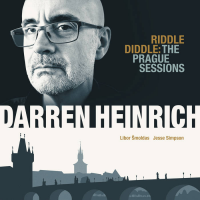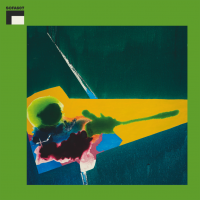Home » Jazz Articles » Album Review » Swedish Jazz 1956-1959: Topsy Theme
Swedish Jazz 1956-1959: Topsy Theme
As he did on Volume 7, Gullin starts the ball rolling with a pair of his compositions, "Fedja" and "Ma," both performed by his octet featuring Domnérus on alto and Norin on tenor. As usual, Gullin is superb, as is alto saxophonist Lundin on "There'll Never Be Another You," a quartet number led by drummer Kenneth Fagerlund. Following "Blue and Misty" by pianist Hallberg?s septet, trumpeters Ericson and Bailey, backed by an all-American rhythm section (pianist Freddie Redd, bassist Tommy Potter, drummer Joe Harris), are as cool as Stockholm in winter on Bailey's bluesy "Guessin'." A young Ernestine Anderson sounds terrific with the Thore Swanerud Trio on "Wrap Your Troubles in Dreams," as do trumpeter Billberg and valve trombonist Järnberg on "Curly Curt." Jansson, the pianist on Fagerlund's quartet, leads his own trio on "The Nearness of You." Tenor Norström wrote "Maid in Sweden" for bassist Gunnar Johnson's quintet, on which he solos along with Johansson and baritone Severö, and trombonist Eje Thelin guides his quintet (with Lalle Svensson on valve trombone) through a swinging version of "Our Love Is Here to Stay." Disc 1 accommodates one big-band number (Gullin's "What a Kick," played by Leif Uvemark's youth orchestra from Malmö, average age around 18), straightforward comments by groups led by Domnérus, Wickman, Brehm and Hallberg, a slice of swing by Norin's septet, two numbers by Hallberg's trio, another vocal ("He's Funny That Way," by Sonya Hedenbratt with the Gunnar Johnson Quintet), trad and "hot" Jazz by the Storyville Creepers and Jan Nyman's Quintet, respectively, and a closing number on which Persson becomes a "trombone section" (an early example of overdubbing) on Theselius' groovy "Mountain Music."
Arnold?s Radio Orchestra opens Disc 2 with a pair of winners from 1957, "Stand By (This Is Harry)" and "Sunday," and Disc 3 with "Quincy's Home Again" and a Domnérus feature, "The Midnight Sun Never Sets," the first recorded in April 1959, the second a year earlier, in April '58, during Jones' visit to Sweden. Also on Disc 2, the "Kenton sound" is replicated by the Gösta Theselius Orchestra on the Johnny Richards-like "Cobra," and there are cogent themes by groups of various sizes led by Domnérus, Gunnar Johnson, Burman, Wickman, Lindell, Norin and trumpeter Allan. The Dixieland component is handled by trumpeter Jack Lidström and the Hep Cats, and the disc embodies vocals by Gunnar Nilson ("Summertime"), Nannie Porres ("Lover Man") and Monica Zetterlund with the Gunnar Svensson Orchestra ("It's All Right with Me"). Also included are a rare recording by eccentric pianist Östen Hedenbratt ("A Dream of Alice") and an early tongue-in-cheek stab at "free Jazz" by Jan Johansson, Gunnar Johnson and Egil Johansen. In the booklet we're told that Svensson wrote the "Topsy Theme" (track 13) especially for Tony Scott but as there's no clarinet solo, only Domnérus on alto, Scott's whereabouts remains a mystery. Allan's quartet closes Disc 2 on a high note with a graceful reading of Rodgers and Hart's "I Could Write a Book."
After Arnold's opening selections on Disc 3, Gullin returns with a quintet featuring Allan's Chet Baker-influenced trumpet to play his "Icarus on the Moon," Zetterlund sings "More Than You Know," and Getz leads his Swedish Jazzmen (including Gullin, Bailey, Norström, Persson, Jan Johansson, Gunnar Johnson and drummer William Schiöpffe) through a sizzling up-tempo reading of Fats Waller's "Honeysuckle Rose." Alice Babs' lone vocal ("New Orleans," with Domnérus and his septet) follows performances by the Eje Thelin-Bosse Skoglund Big Band, trumpeter Åke Jönsson's septet, baritone Lennart Jansson's trio, two numbers by pianist Lars Werner, "Waltz for Nannie" (unaccompanied) and "In the Fall" (trio) and one by the Malte Johnson Orchestra. Completing the exceptionally well-chosen program are charming snapshots by Domnérus' septet (Miles Davis' "Milestones"), pianist Öfwerman's trio, tenor saxophonist Björksten's septet, an improvised "after-session" vocal ("My Funny Valentine") by Zetterlund with Persson on trombone and Theselius on piano, Gunnar Lundén-Welden and the Special Studio Orchestra of Radio Sweden ("Lulu's Back in Town"), Wallin's intrepid tentet featuring Nerem's tenor, "The Late Late Show" sung by the Linn-Tones (Ruth Linn, Pete Jacques), an interview (in Swedish, of course) with Allan and Reidel, and their closing duet, "SoldI Musik."
The years 1956-59 may not have been entirely golden for Jazz in Sweden, but there are more than enough valuable nuggets here to satisfy almost any prospector. Whatever the framework the Swedes always swung, and with such marvelous players as Gullin, Domnérus, Wickman, Hallberg and others leading the charge, they were never more than a step or two behind the pace-setting Americans, a remarkable accomplishment when one considers that Jazz was imported to Sweden from the land of its birth and that Swedish musicians learned to play the music primarily by listening to and emulating its creators.
Contact: STIM / Svensk Musik (Swedish Music Center), Box 27327, SE-102 54, Stockholm, Sweden. Phone +46 8 783 88 00. E-mail [email protected]; web site, www.mic.stim.se
Track Listing
Disc 1 -- Fedja; Ma; There'll Never Be Another You; Blue and Misty; Guessin'; Wrap Your Troubles in Dreams; Curly Curt; The Nearness of You; Maid in Sweden; He's Funny That Way; Our Love Is Here to Stay; There Ain't No Sweet Man; What a Kick; Practically Duke; Swinging the Blues; Shivers; Combien; "Komplex Suss"; Dinah; Dr.'s Special (77:47). Disc 2 -- Stand By (This Is Harry); Sunday; Fascinating Rhythm; Summertime; Go Home Swanson; My Old Cat Felix; A Dream of Alice; The Definite New Jazz Suite; Lover Man; I'll Remember April; Cobra; Blues
Personnel
Disc 1 ? Lars Gullin Octet; Kenneth Fagerlund-Willy Lundin Quartet; Bengt Hallberg Ensemble; Rolf Ericson-Benny Bailey Quintet; Ernestine Anderson-Thore Swaneruds Trio; Rolf Billberg Quintet; Jan Johansson Trio; Gunnar Johnson Quintet; Sonya Hedenbratt; Eje Thelin Quintet; Storyville Creepers; Leif Uvemark Orchestra; Arne Domn
Album information
Title: Topsy Theme | Year Released: 2002 | Record Label: Caprice Records
Tags
PREVIOUS / NEXT
Support All About Jazz
 All About Jazz has been a pillar of jazz since 1995, championing it as an art form and, more importantly, supporting the musicians who make it. Our enduring commitment has made "AAJ" one of the most culturally important websites of its kind, read by hundreds of thousands of fans, musicians and industry figures every month.
All About Jazz has been a pillar of jazz since 1995, championing it as an art form and, more importantly, supporting the musicians who make it. Our enduring commitment has made "AAJ" one of the most culturally important websites of its kind, read by hundreds of thousands of fans, musicians and industry figures every month.

















